Abstract
The total potential energy profile for hydrophobic ion interactions with lipid bilayers can be written as the sum of four terms: the electrical Born, image and dipole contributions, and a neutral energy term. We introduce a specific model for the membrane dipole potential, treating it as a two-dimensional array of point dipoles located near each membrane-water interface. Together with specific theoretical models for the other energy terms, a total potential profile is developed that successfully describes the complete set of thermodynamic parameters for binding and translocation for the two hydrophobic ion structural analogues, tetraphenylphosphonium (TPP+) and tetraphenylboron (TPB-). A reasonable fit to the data is possible if the dipole potential energy has a magnitude of 5.5 + 0.5 kcal/mol (240 + 20 mV), positive inside, and if the neutral energy contribution for TPP+ and TPB- is -7.0 + 1.0 kcal/mol. These results may also have important implications for small ion interactions with membranes and the energetics of charged groups in membrane proteins.
Full text
PDF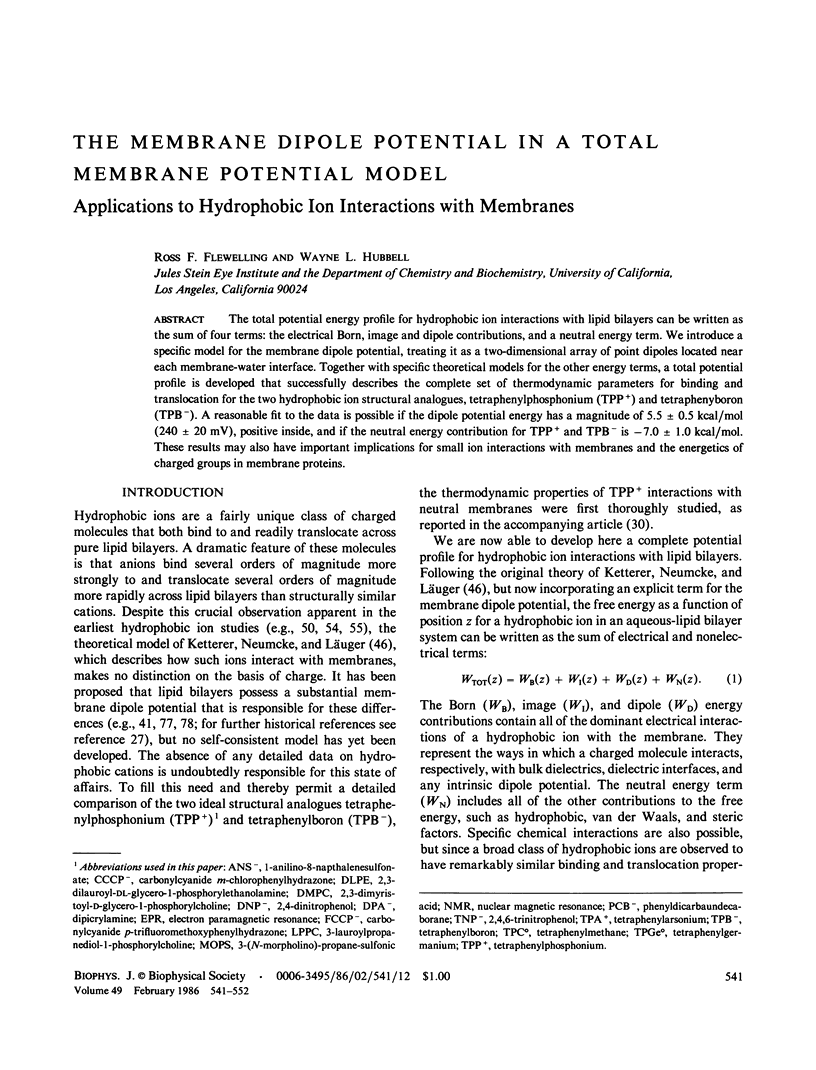
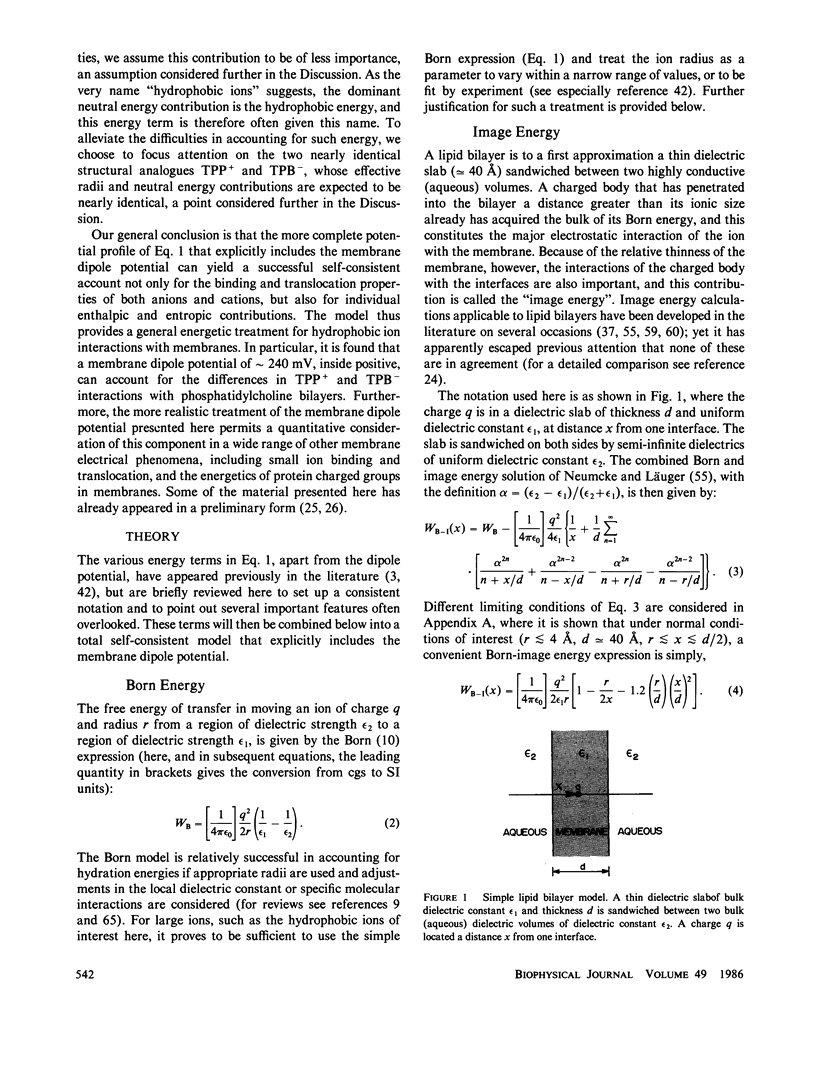
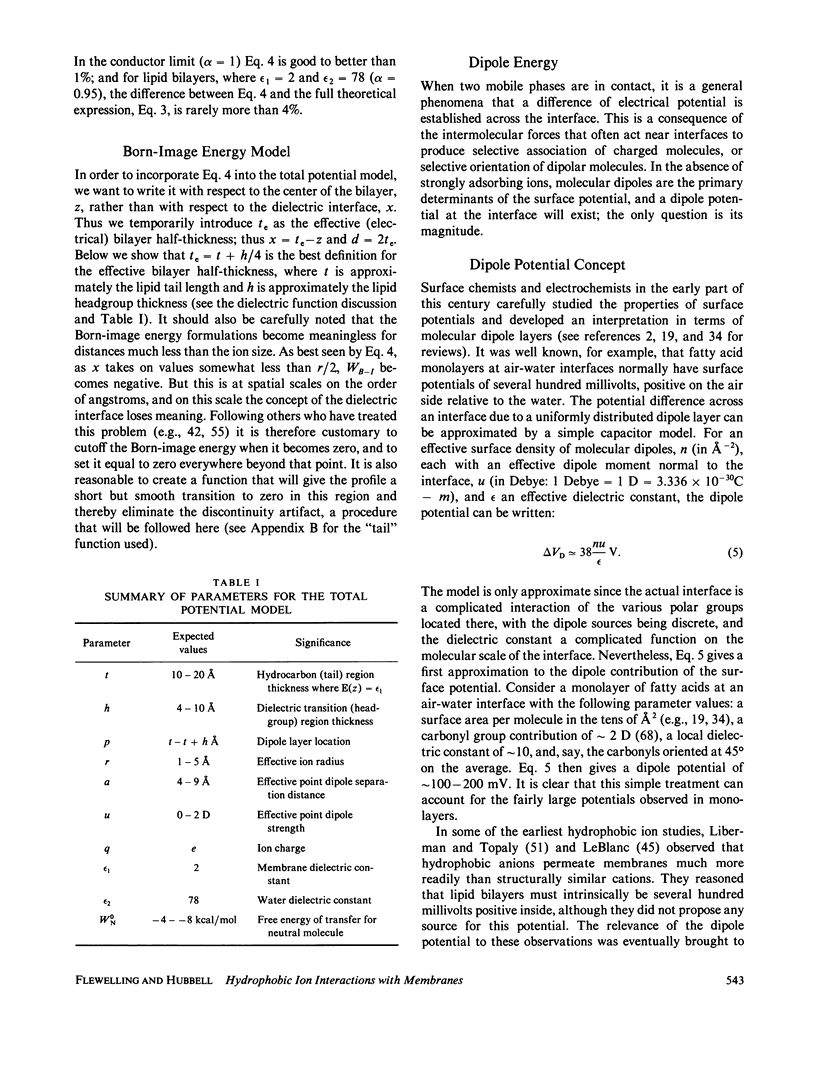
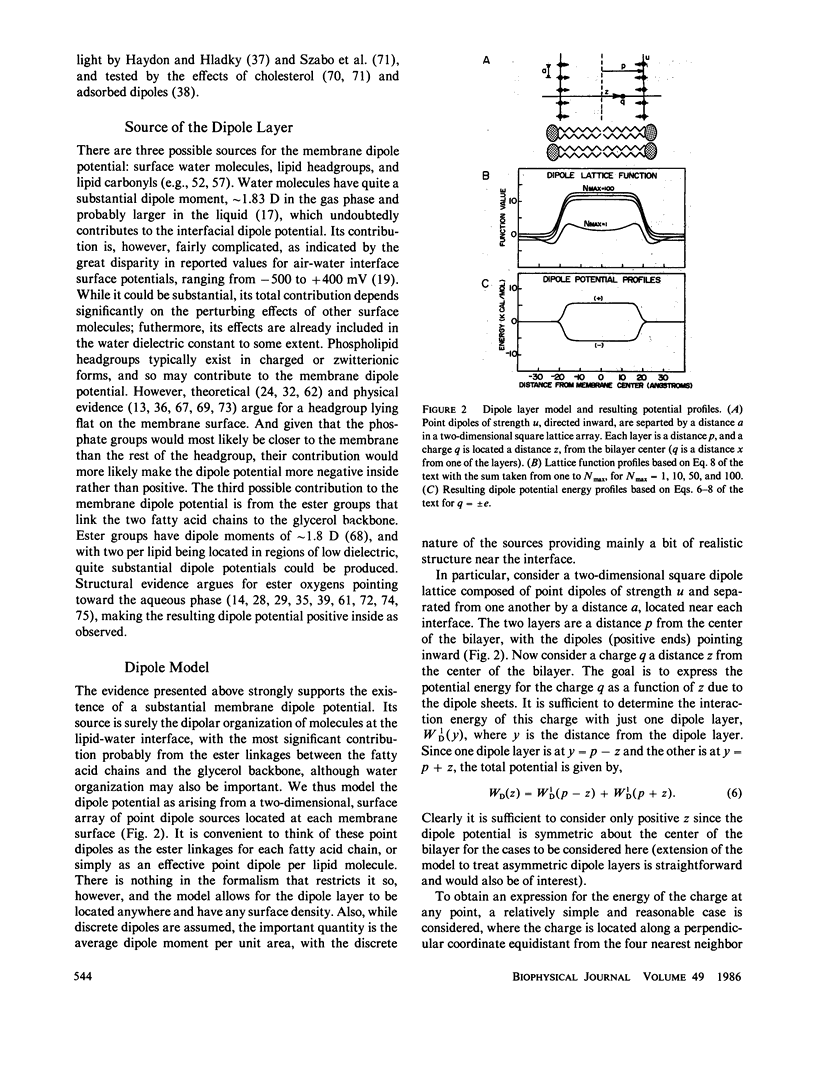
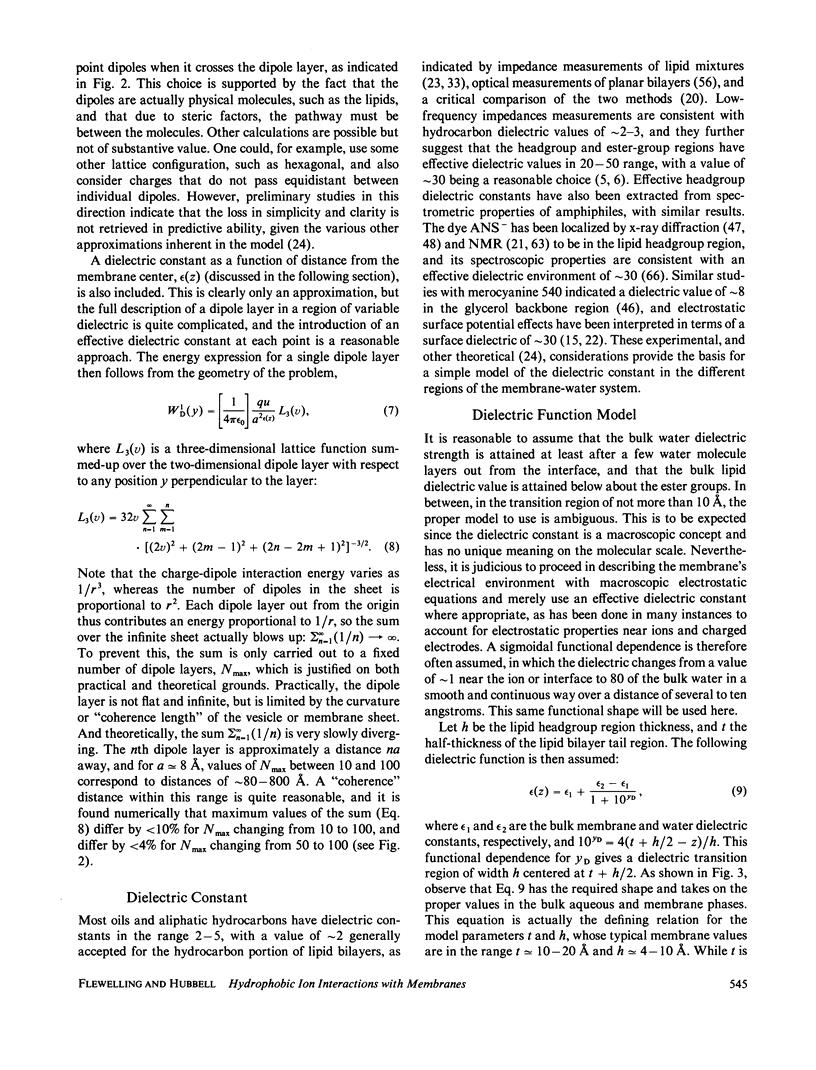




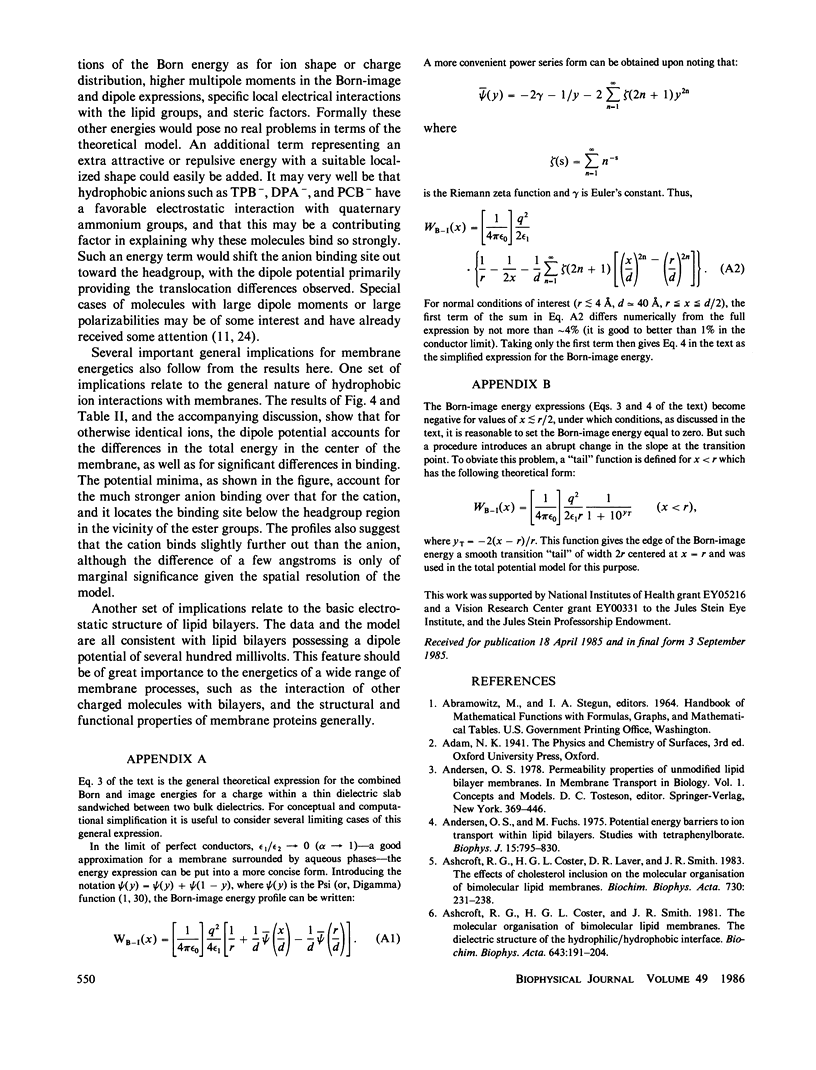

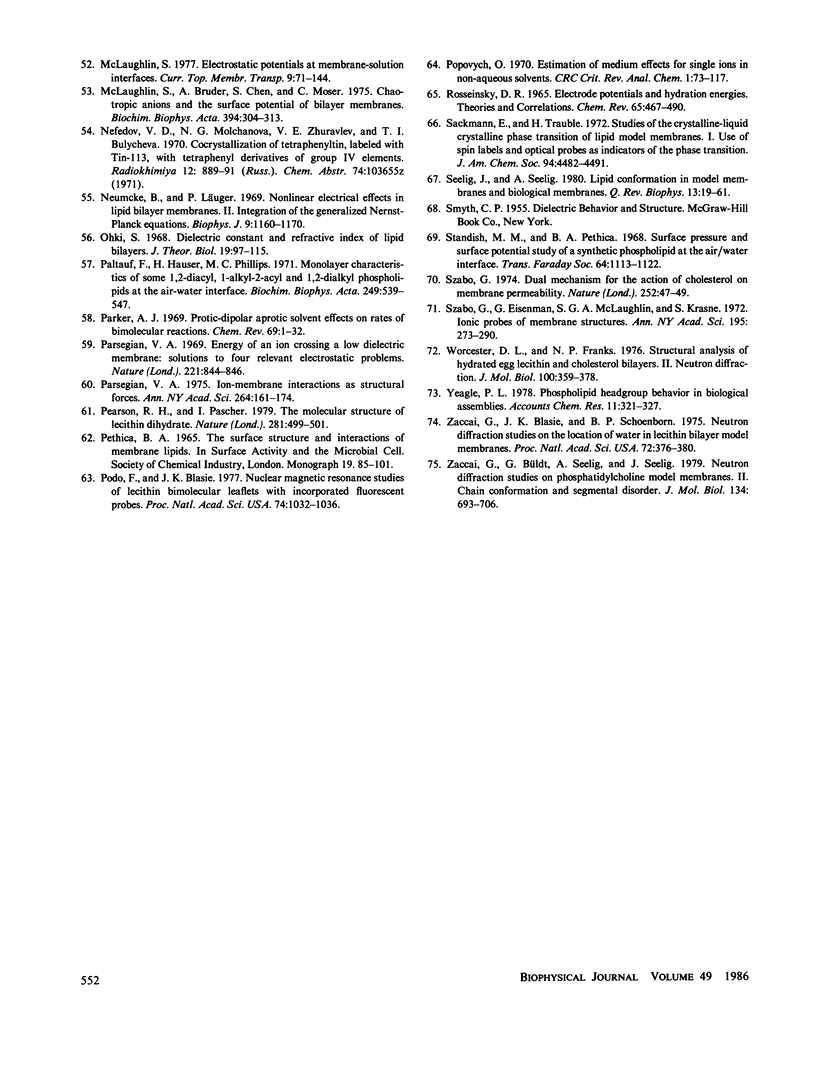
Selected References
These references are in PubMed. This may not be the complete list of references from this article.
- Andersen O. S., Fuchs M. Potential energy barriers to ion transport within lipid bilayers. Studies with tetraphenylborate. Biophys J. 1975 Aug;15(8):795–830. doi: 10.1016/S0006-3495(75)85856-5. [DOI] [PMC free article] [PubMed] [Google Scholar]
- Ashcroft R. G., Coster H. G., Smith J. R. The molecular organisation of bimolecular lipid membranes. The dielectric structure of the hydrophilic/hydrophobic interface. Biochim Biophys Acta. 1981 Apr 22;643(1):191–204. doi: 10.1016/0005-2736(81)90232-7. [DOI] [PubMed] [Google Scholar]
- Benz R., Fröhlich O., Läuger P., Montal M. Electrical capacity of black lipid films and of lipid bilayers made from monolayers. Biochim Biophys Acta. 1975 Jul 3;394(3):323–334. doi: 10.1016/0005-2736(75)90287-4. [DOI] [PubMed] [Google Scholar]
- Bradshaw R. W., Robertson C. R. Effect of ionic polarizability on electrodiffusion in lipid bilayer membranes. J Membr Biol. 1975 Dec 4;25(1-2):93–114. doi: 10.1007/BF01868570. [DOI] [PubMed] [Google Scholar]
- Bruner L. J. The interaction of hydrophobic ions with lipid bilayer membranes. J Membr Biol. 1975;22(2):125–141. doi: 10.1007/BF01868167. [DOI] [PubMed] [Google Scholar]
- Büldt G., Gally H. U., Seelig A., Seelig J., Zaccai G. Neutron diffraction studies on selectively deuterated phospholipid bilayers. Nature. 1978 Jan 12;271(5641):182–184. doi: 10.1038/271182a0. [DOI] [PubMed] [Google Scholar]
- Büldt G., Wohlgemuth R. The headgroup conformation of phospholipids in membranes. J Membr Biol. 1981 Feb 15;58(2):81–100. doi: 10.1007/BF01870972. [DOI] [PubMed] [Google Scholar]
- Cevc G., Watts A., Marsh D. Titration of the phase transition of phosphatidylserine bilayer membranes. Effects of pH, surface electrostatics, ion binding, and head-group hydration. Biochemistry. 1981 Aug 18;20(17):4955–4965. doi: 10.1021/bi00520a023. [DOI] [PubMed] [Google Scholar]
- Franks N. P., Lieb W. R. The structure of lipid bilayers and the effects of general anaesthetics. An x-ray and neutron diffraction study. J Mol Biol. 1979 Oct 9;133(4):469–500. doi: 10.1016/0022-2836(79)90403-0. [DOI] [PubMed] [Google Scholar]
- Franks N. P. Structural analysis of hydrated egg lecithin and cholesterol bilayers. I. X-ray diffraction. J Mol Biol. 1976 Jan 25;100(3):345–358. doi: 10.1016/s0022-2836(76)80067-8. [DOI] [PubMed] [Google Scholar]
- Hanai T., Haydon D. A., Taylor J. Polar group orientation and the electrical properties of lecithin bimolecular leaflets. J Theor Biol. 1965 Sep;9(2):278–296. doi: 10.1016/0022-5193(65)90113-x. [DOI] [PubMed] [Google Scholar]
- Hanai T., Haydon D. A., Taylor J. The influence of lipid composition and of some adsorbed proteins on the capacitance of black hydrocarbon membranes. J Theor Biol. 1965 Nov;9(3):422–432. doi: 10.1016/0022-5193(65)90041-x. [DOI] [PubMed] [Google Scholar]
- Hauser H., Pascher I., Pearson R. H., Sundell S. Preferred conformation and molecular packing of phosphatidylethanolamine and phosphatidylcholine. Biochim Biophys Acta. 1981 Jun 16;650(1):21–51. doi: 10.1016/0304-4157(81)90007-1. [DOI] [PubMed] [Google Scholar]
- Hauser H., Pascher I., Sundell S. Conformation of phospholipids. Crystal structure of a lysophosphatidylcholine analogue. J Mol Biol. 1980 Mar 5;137(3):249–264. doi: 10.1016/0022-2836(80)90315-0. [DOI] [PubMed] [Google Scholar]
- Haydon D. A., Hladky S. B. Ion transport across thin lipid membranes: a critical discussion of mechanisms in selected systems. Q Rev Biophys. 1972 May;5(2):187–282. doi: 10.1017/s0033583500000883. [DOI] [PubMed] [Google Scholar]
- Haydon D. A., Myers V. B. Surface charge, surface dipoles and membrane conductance. Biochim Biophys Acta. 1973 May 25;307(3):429–443. doi: 10.1016/0005-2736(73)90289-7. [DOI] [PubMed] [Google Scholar]
- Hitchcock P. B., Mason R., Thomas K. M., Shipley G. G. Structural chemistry of 1,2 dilauroyl-DL-phosphatidylethanolamine: molecular conformation and intermolecular packing of phospholipids. Proc Natl Acad Sci U S A. 1974 Aug;71(8):3036–3040. doi: 10.1073/pnas.71.8.3036. [DOI] [PMC free article] [PubMed] [Google Scholar]
- Jordan P. C. Electrostatic modeling of ion pores. II. Effects attributable to the membrane dipole potential. Biophys J. 1983 Feb;41(2):189–195. doi: 10.1016/S0006-3495(83)84419-1. [DOI] [PMC free article] [PubMed] [Google Scholar]
- Kleijn W. B., Bruner L. J., Midland M. M., Wisniewski J. Hydrophobic ion probe studies of membrane dipole potentials. Biochim Biophys Acta. 1983 Jan 19;727(2):357–366. doi: 10.1016/0005-2736(83)90421-2. [DOI] [PubMed] [Google Scholar]
- Lelkes P. I., Miller I. R. Perturbations of membrane structure by optical probes: I. Location and structural sensitivity of merocyanine 540 bound to phospholipid membranes. J Membr Biol. 1980 Jan 31;52(1):1–15. doi: 10.1007/BF01869001. [DOI] [PubMed] [Google Scholar]
- Lesslauer W., Cain J. E., Blasie J. K. X-ray diffraction studies of lecithin bimolecular leaflets with incorporated fluorescent probes. Proc Natl Acad Sci U S A. 1972 Jun;69(6):1499–1503. doi: 10.1073/pnas.69.6.1499. [DOI] [PMC free article] [PubMed] [Google Scholar]
- Lesslauer W., Cain J., Blasie J. K. On the location of I-anilino-8-naphthalene-sulfonate in lipid model systems. An x-ray diffraction study. Biochim Biophys Acta. 1971 Aug 13;241(2):547–566. doi: 10.1016/0005-2736(71)90054-x. [DOI] [PubMed] [Google Scholar]
- Liberman E. A., Topaly V. P. Selective transport of ions through bimolecular phospholipid membranes. Biochim Biophys Acta. 1968 Sep 17;163(2):125–136. doi: 10.1016/0005-2736(68)90089-8. [DOI] [PubMed] [Google Scholar]
- McLaughlin S., Bruder A., Chen S., Moser C. Chaotropic anions and the surface potential of bilayer membranes. Biochim Biophys Acta. 1975 Jun 25;394(2):304–313. doi: 10.1016/0005-2736(75)90267-9. [DOI] [PubMed] [Google Scholar]
- Neumcke B., Läuger P. Nonlinear electrical effects in lipid bilayer membranes. II. Integration of the generalized Nernst-Planck equations. Biophys J. 1969 Sep;9(9):1160–1170. doi: 10.1016/S0006-3495(69)86443-X. [DOI] [PMC free article] [PubMed] [Google Scholar]
- Oki S. Dielectric constant and refractive index of lipid bilayers. J Theor Biol. 1968 Apr;19(1):97–115. doi: 10.1016/0022-5193(68)90008-8. [DOI] [PubMed] [Google Scholar]
- Paltauf F., Hauser H., Phillips M. C. Monolayer characteristics of some 1,2-diacyl, I-alkyl-2-acyl and 1,2-dialkyl phospholipids at the air-water interface. Biochim Biophys Acta. 1971 Dec 3;249(2):539–547. doi: 10.1016/0005-2736(71)90129-5. [DOI] [PubMed] [Google Scholar]
- Parsegian A. Energy of an ion crossing a low dielectric membrane: solutions to four relevant electrostatic problems. Nature. 1969 Mar 1;221(5183):844–846. doi: 10.1038/221844a0. [DOI] [PubMed] [Google Scholar]
- Parsegian V. A. Ion-membrane interactions as structural forces. Ann N Y Acad Sci. 1975 Dec 30;264:161–171. doi: 10.1111/j.1749-6632.1975.tb31481.x. [DOI] [PubMed] [Google Scholar]
- Pearson R. H., Pascher I. The molecular structure of lecithin dihydrate. Nature. 1979 Oct 11;281(5731):499–501. doi: 10.1038/281499a0. [DOI] [PubMed] [Google Scholar]
- Podo F., Blasie J. K. Nuclear magnetic resonance studies of lecithin bimolecular leaflets with incorporated fluorescent probes. Proc Natl Acad Sci U S A. 1977 Mar;74(3):1032–1036. doi: 10.1073/pnas.74.3.1032. [DOI] [PMC free article] [PubMed] [Google Scholar]
- Sackmann E., Träuble H. Studies of the crystalline-liquid crystalline phase transition of lipid model membranes. I. Use of spin labels and optical probes as indicators of the phase transition. J Am Chem Soc. 1972 Jun 28;94(13):4482–4491. doi: 10.1021/ja00768a013. [DOI] [PubMed] [Google Scholar]
- Seelig J., Seelig A. Lipid conformation in model membranes and biological membranes. Q Rev Biophys. 1980 Feb;13(1):19–61. doi: 10.1017/s0033583500000305. [DOI] [PubMed] [Google Scholar]
- Szabo G. Dual mechanism for the action of cholesterol on membrane permeability. Nature. 1974 Nov 1;252(5478):47–49. doi: 10.1038/252047a0. [DOI] [PubMed] [Google Scholar]
- Szabo G., Eisenman G., McLaughlin S. G., Krasne S. Ionic probes of membrane structures. Ann N Y Acad Sci. 1972 Jun 20;195:273–290. [PubMed] [Google Scholar]
- Worcester D. L., Franks N. P. Structural analysis of hydrated egg lecithin and cholesterol bilayers. II. Neutrol diffraction. J Mol Biol. 1976 Jan 25;100(3):359–378. doi: 10.1016/s0022-2836(76)80068-x. [DOI] [PubMed] [Google Scholar]
- Zaccai G., Blasie J. K., Schoenborn B. P. Neutron diffraction studies on the location of water in lecithin bilayer model membranes. Proc Natl Acad Sci U S A. 1975 Jan;72(1):376–380. doi: 10.1073/pnas.72.1.376. [DOI] [PMC free article] [PubMed] [Google Scholar]
- Zaccai G., Büldt G., Seelig A., Seelig J. Neutron diffraction studies on phosphatidylcholine model membranes. II. Chain conformation and segmental disorder. J Mol Biol. 1979 Nov 15;134(4):693–706. doi: 10.1016/0022-2836(79)90480-7. [DOI] [PubMed] [Google Scholar]


